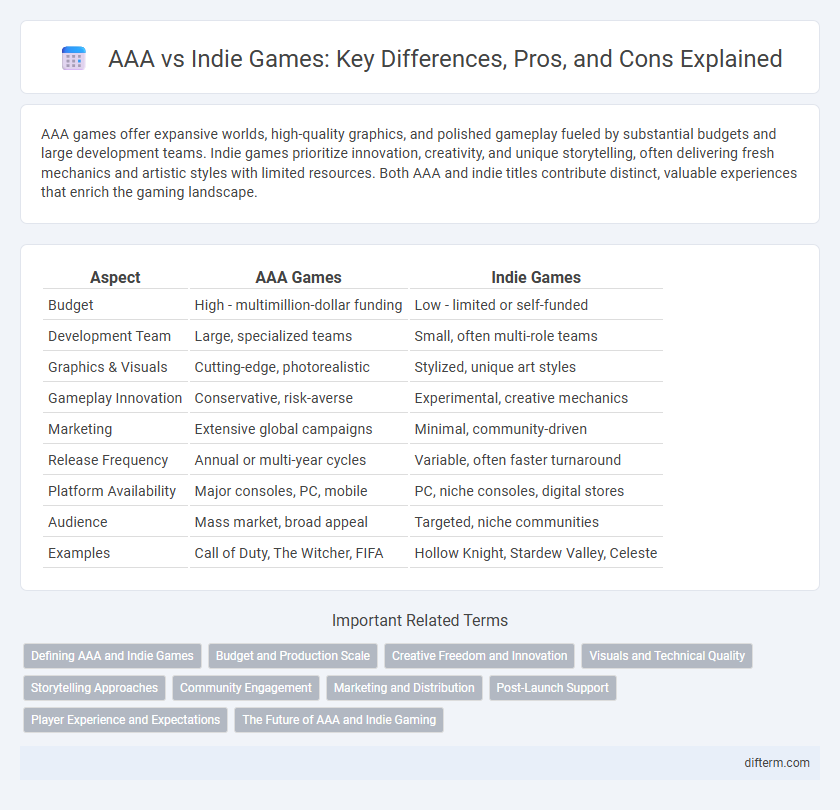AAA games offer expansive worlds, high-quality graphics, and polished gameplay fueled by substantial budgets and large development teams. Indie games prioritize innovation, creativity, and unique storytelling, often delivering fresh mechanics and artistic styles with limited resources. Both AAA and indie titles contribute distinct, valuable experiences that enrich the gaming landscape.
Table of Comparison
| Aspect | AAA Games | Indie Games |
|---|---|---|
| Budget | High - multimillion-dollar funding | Low - limited or self-funded |
| Development Team | Large, specialized teams | Small, often multi-role teams |
| Graphics & Visuals | Cutting-edge, photorealistic | Stylized, unique art styles |
| Gameplay Innovation | Conservative, risk-averse | Experimental, creative mechanics |
| Marketing | Extensive global campaigns | Minimal, community-driven |
| Release Frequency | Annual or multi-year cycles | Variable, often faster turnaround |
| Platform Availability | Major consoles, PC, mobile | PC, niche consoles, digital stores |
| Audience | Mass market, broad appeal | Targeted, niche communities |
| Examples | Call of Duty, The Witcher, FIFA | Hollow Knight, Stardew Valley, Celeste |
Defining AAA and Indie Games
AAA games are high-budget, high-profile titles developed by large studios with extensive resources, aiming for broad market appeal and cutting-edge graphics. Indie games are created by smaller teams or individual developers, often emphasizing innovative gameplay, unique storytelling, and artistic expression over massive production values. The distinction lies primarily in scale, budget, and creative freedom, with AAA focusing on blockbuster experiences and indie games fostering niche, experimental content.
Budget and Production Scale
AAA games typically command multi-million dollar budgets, often exceeding $100 million, allowing for expansive production teams and cutting-edge technology. Indie games operate on significantly smaller budgets, frequently under $1 million, resulting in leaner development teams and more focused, innovative gameplay experiences. The disparity in budget and production scale directly influences the scope, quality, and marketing reach of AAA versus indie gaming projects.
Creative Freedom and Innovation
Indie games often showcase unparalleled creative freedom, allowing developers to experiment with unique mechanics and storytelling without the pressure of mass-market appeal. AAA titles, while benefiting from substantial budgets and advanced technology, frequently prioritize proven formulas to maximize commercial success, potentially limiting innovation. The contrast highlights how indie studios drive fresh ideas and niche experiences, whereas AAA studios refine and scale popular concepts.
Visuals and Technical Quality
AAA games typically showcase cutting-edge graphics and high technical quality due to substantial budgets and large development teams, resulting in realistic textures, advanced lighting, and smooth performance. Indie games often emphasize unique artistic styles and creativity, sometimes sacrificing hyper-realistic visuals for distinctive aesthetic appeal and innovation. Technical polish in AAA titles is usually more consistent, while indie games may experience variability depending on resource constraints.
Storytelling Approaches
AAA games often feature expansive narratives with high production values and complex character development, leveraging large teams to create immersive, cinematic experiences. Indie games prioritize unique, innovative storytelling, frequently exploring personal or unconventional themes through experimental mechanics and artistic expression. Both approaches offer distinct emotional engagement, with AAA titles delivering polished blockbusters and indie games providing intimate, thought-provoking narratives.
Community Engagement
AAA games often leverage extensive marketing budgets to build large, but sometimes passive, communities through polished content and widespread promotional campaigns. Indie games, by contrast, tend to foster more intimate and engaged communities by involving players directly in development via feedback loops and frequent updates. This grassroots approach often results in stronger player loyalty and active participation in shaping the game's evolution.
Marketing and Distribution
AAA games rely heavily on extensive marketing budgets, leveraging global advertising campaigns, influencer partnerships, and major platform launches to ensure widespread visibility. Indie games often utilize grassroots marketing strategies such as social media engagement, community building, and crowdfunding to reach niche audiences. Distribution for AAA titles typically involves multi-platform releases through major digital storefronts and retail partnerships, while indie developers often depend on digital distribution channels like Steam, itch.io, and Epic Games Store to minimize costs and maximize reach.
Post-Launch Support
AAA games typically receive extensive post-launch support, including frequent content updates, patches, and expansions funded by significant budgets. Indie games often rely on smaller teams for post-launch improvements, focusing on community feedback and unique content additions rather than large-scale updates. The difference in resources and scale heavily influences the scope and frequency of post-launch support between AAA and indie titles.
Player Experience and Expectations
AAA games deliver high-budget visuals, expansive worlds, and polished gameplay, meeting player expectations for immersive and high-quality experiences. Indie games often prioritize innovative mechanics and unique storytelling, attracting players seeking creativity and emotional depth. Both categories shape player experience by balancing technical excellence with originality, catering to diverse gaming preferences.
The Future of AAA and Indie Gaming
The future of AAA gaming is poised to leverage cutting-edge technology such as ray tracing, AI-driven narratives, and expansive open-world designs to deliver immersive experiences with blockbuster budgets and mass-market appeal. Indie gaming continues to thrive through innovation, unique storytelling, and artistic freedom, often pushing boundaries in gameplay mechanics and niche genres that larger studios may overlook. Emerging trends like cloud gaming, cross-platform play, and community-driven development are shaping a landscape where both AAA and indie games coexist, offering diverse experiences to a global gaming audience.
AAA vs Indie Infographic

 difterm.com
difterm.com